
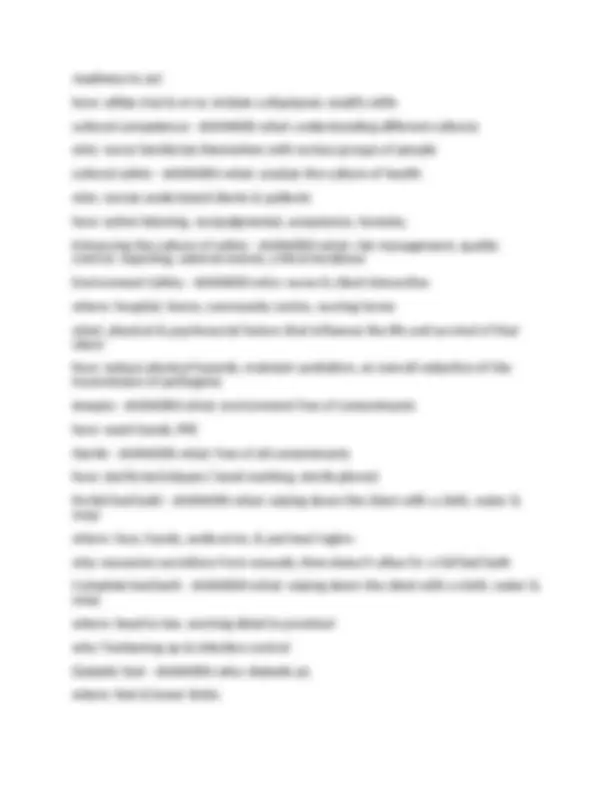
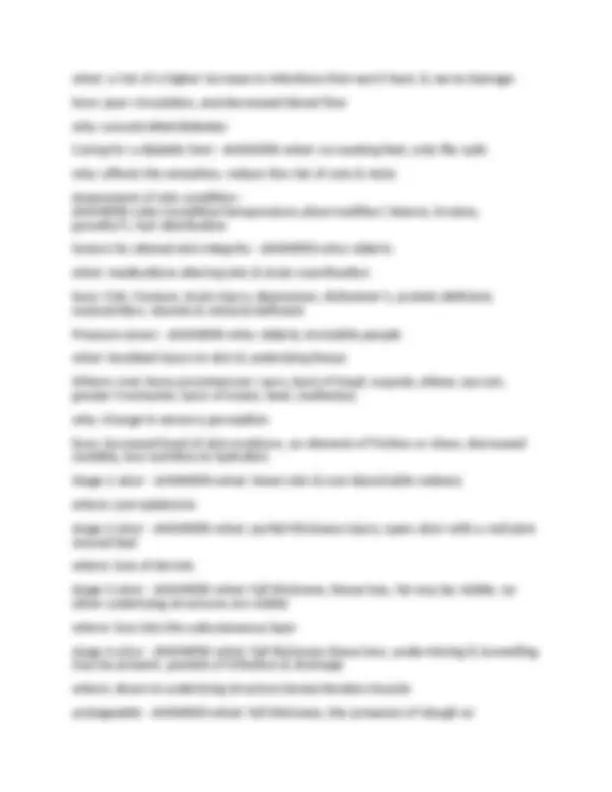
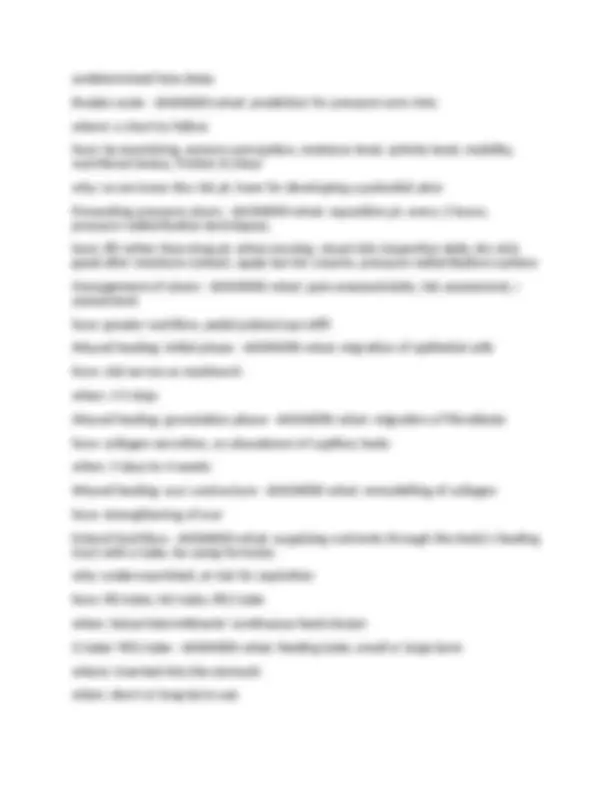
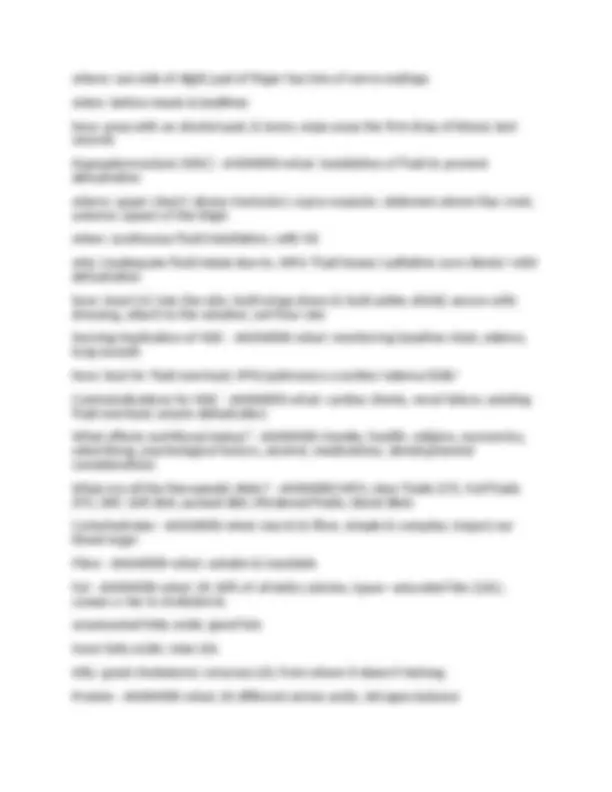
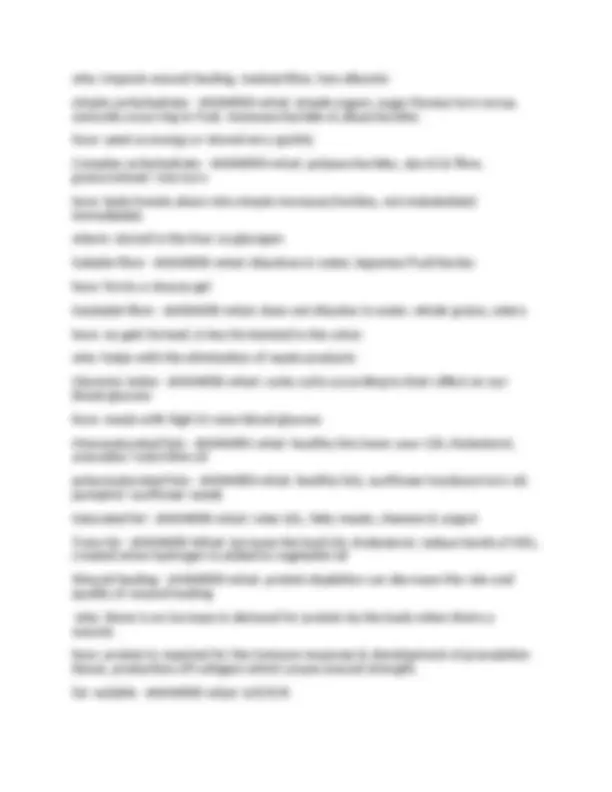
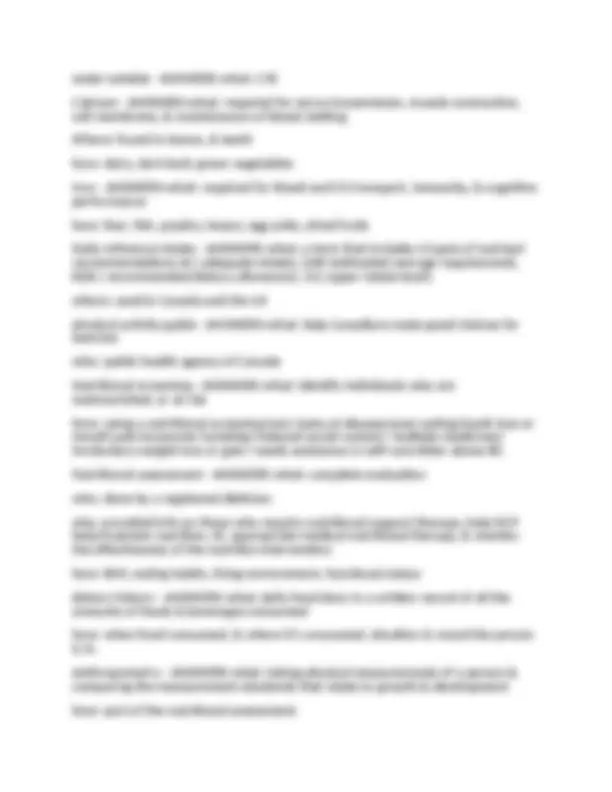
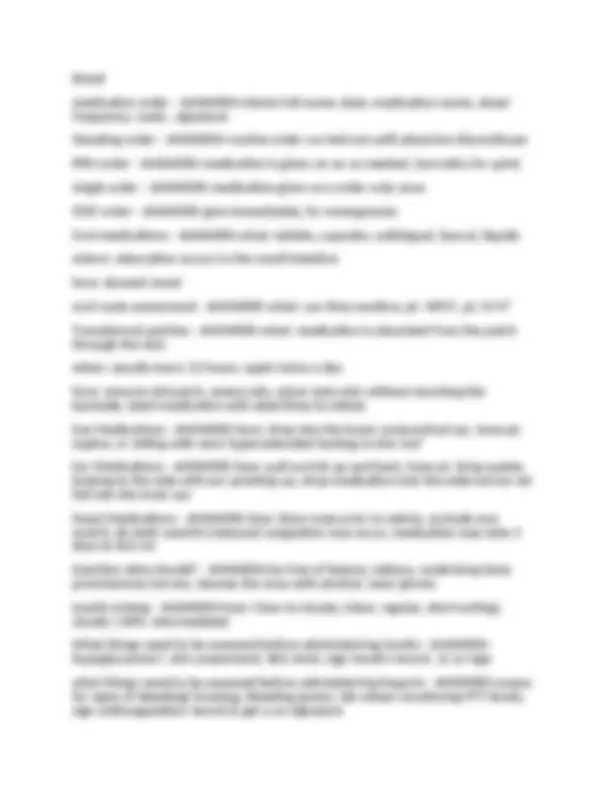
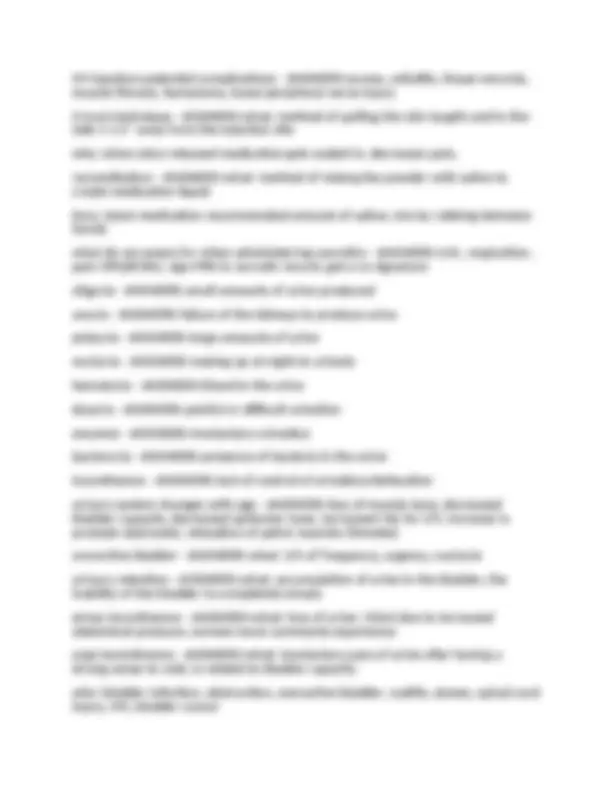
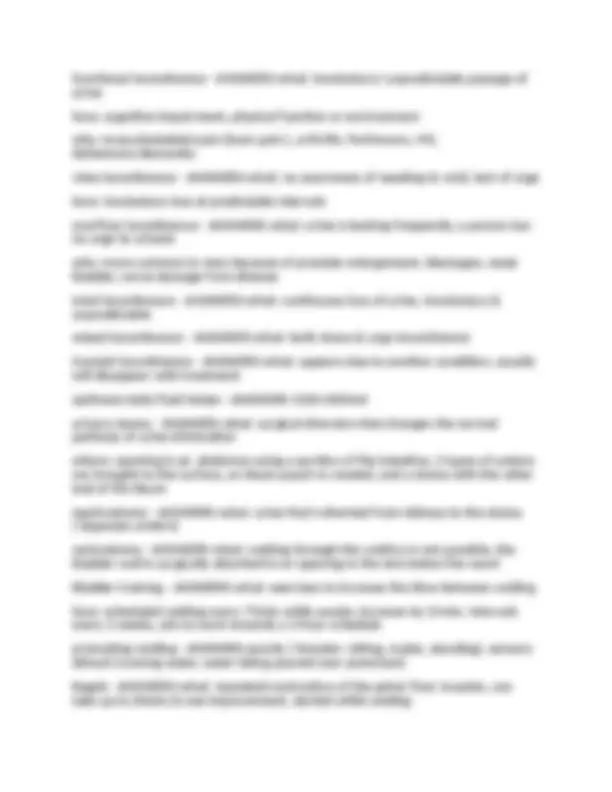
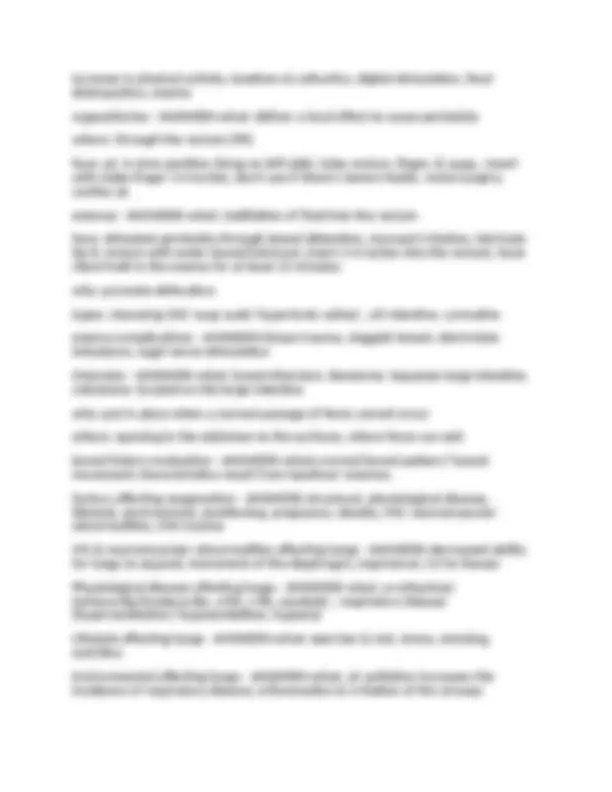
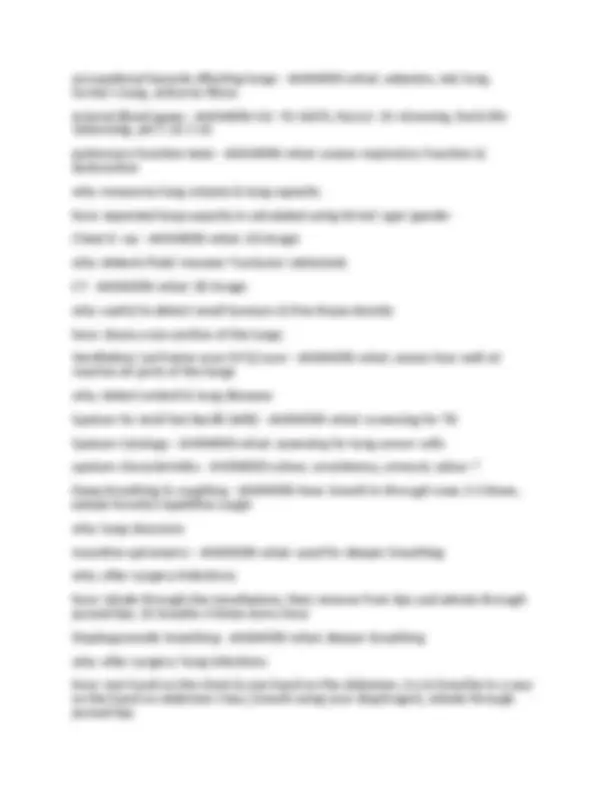
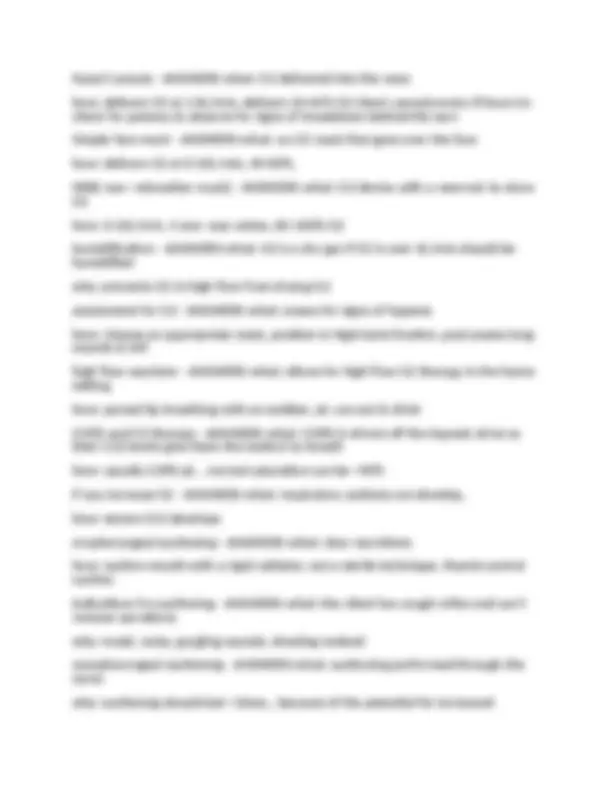
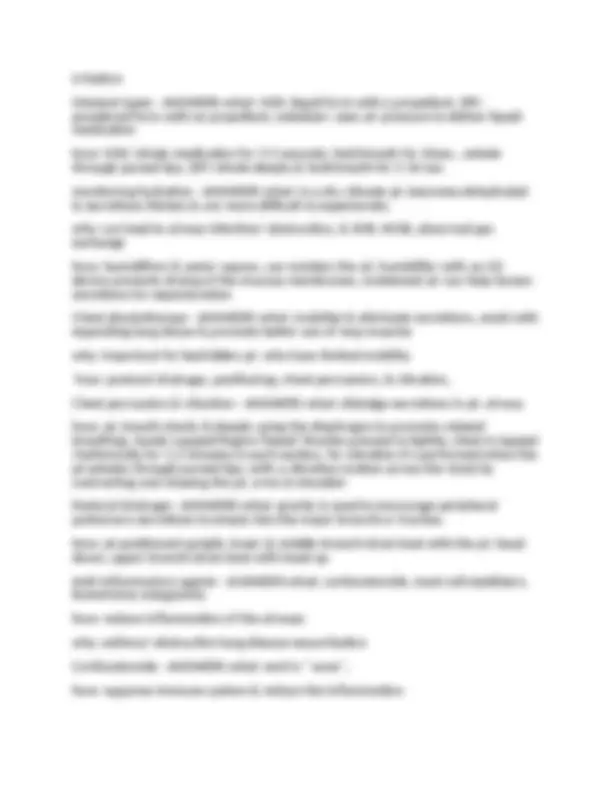
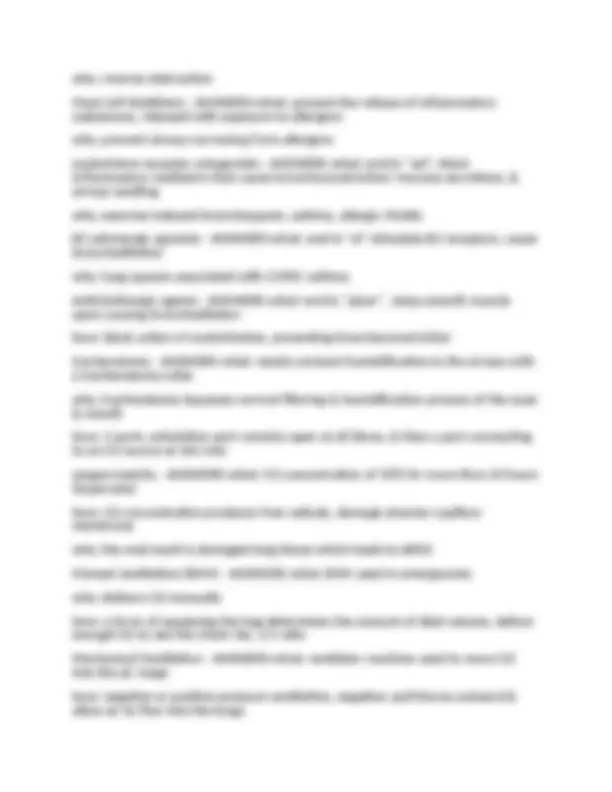
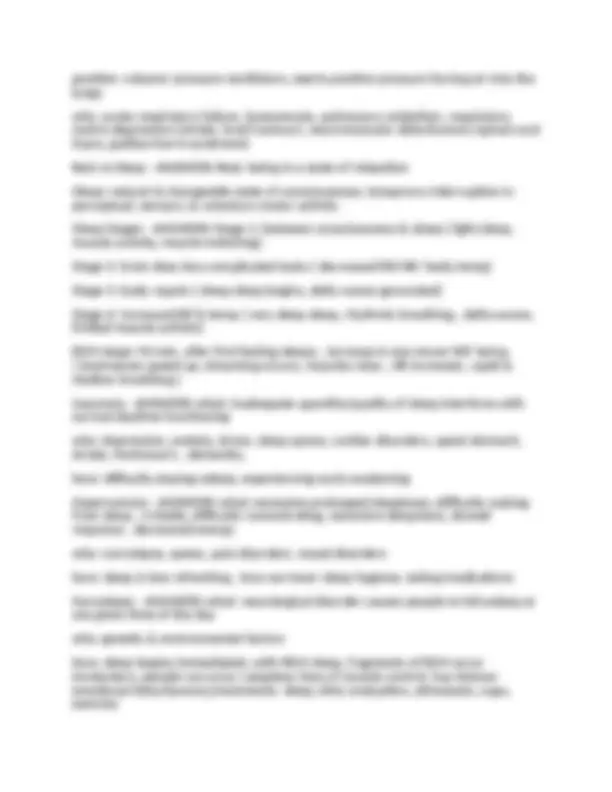
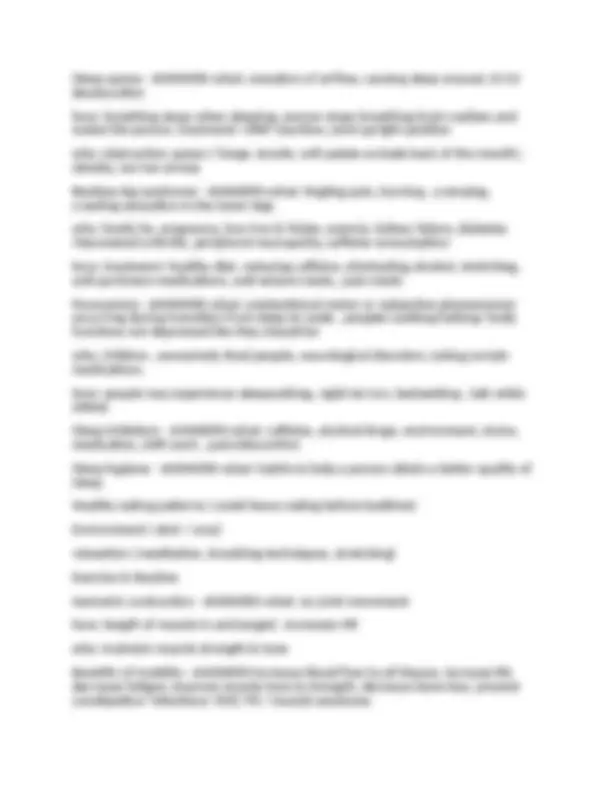
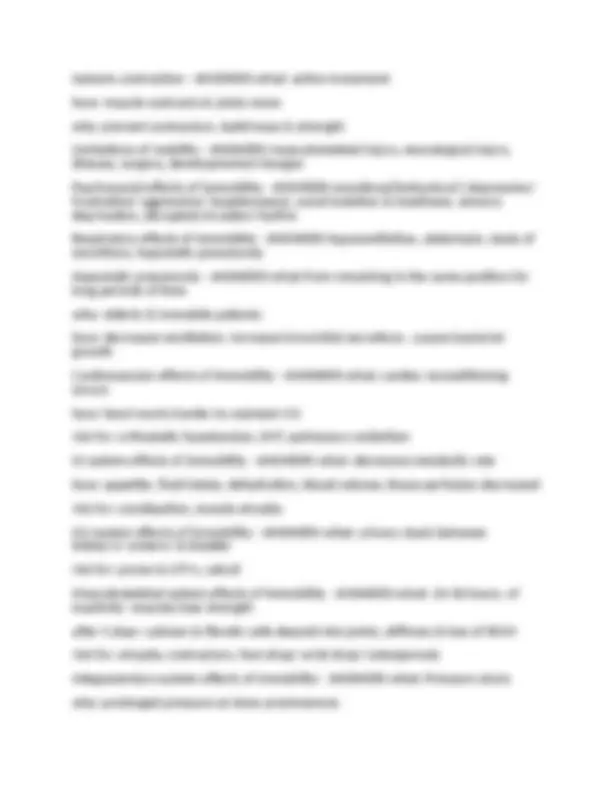
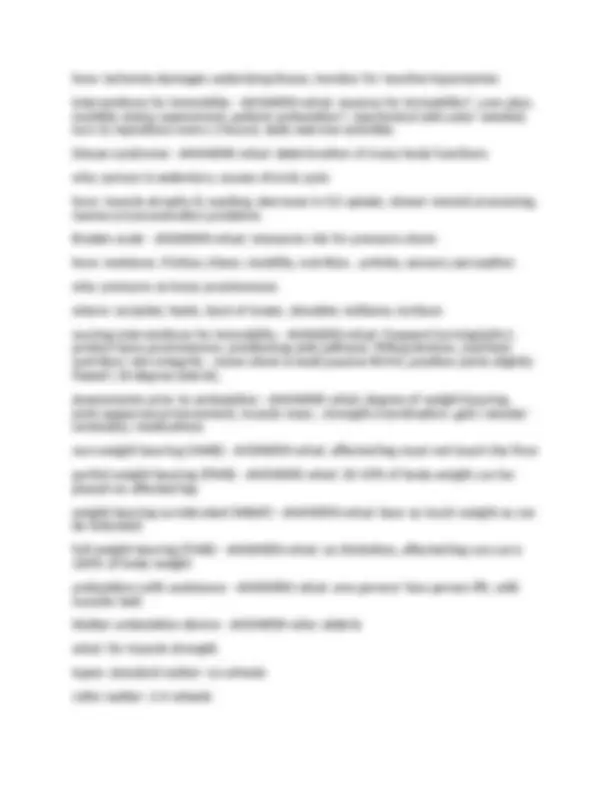

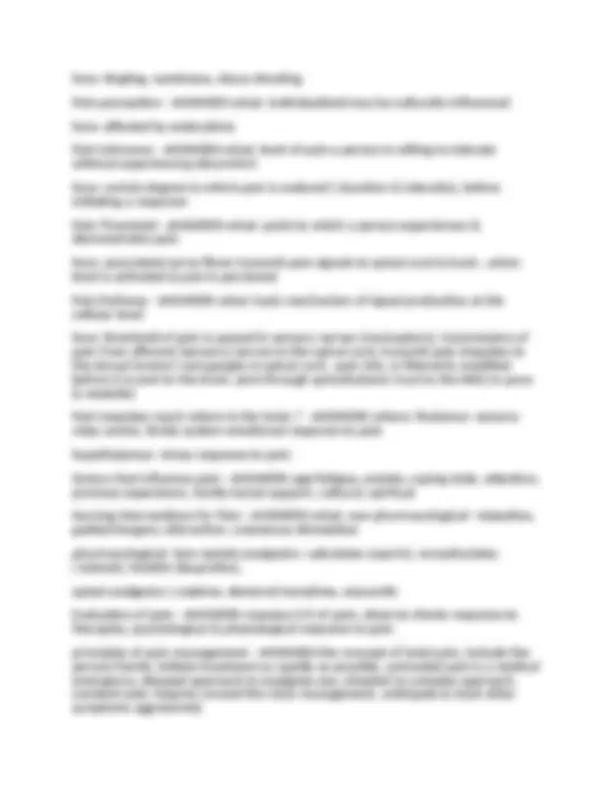
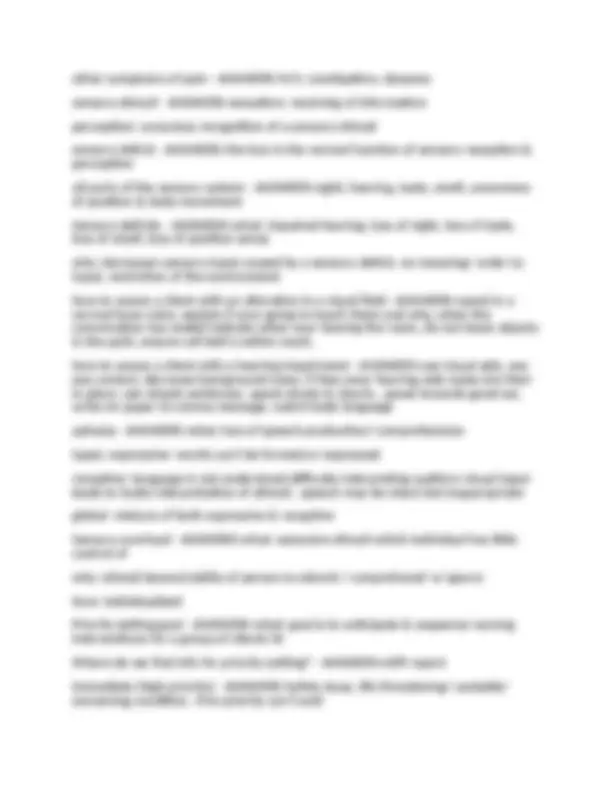
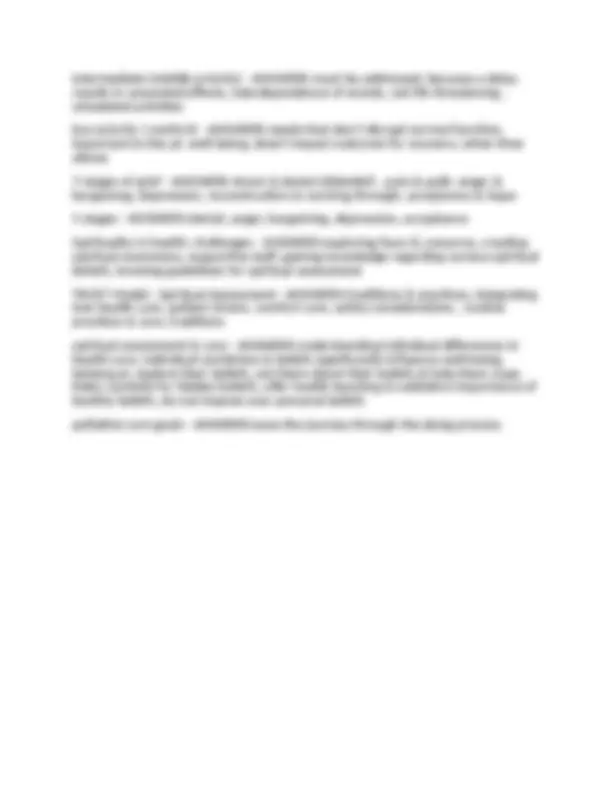


Study with the several resources on Docsity

Earn points by helping other students or get them with a premium plan


Prepare for your exams
Study with the several resources on Docsity

Earn points to download
Earn points by helping other students or get them with a premium plan
Community
Ask the community for help and clear up your study doubts
Discover the best universities in your country according to Docsity users
Free resources
Download our free guides on studying techniques, anxiety management strategies, and thesis advice from Docsity tutors
NURS1002-FINAL QUESTIONS WITH COMPLETE ANSWERS 2025 GRADED A+ LATEST UPDATE. NURS1002-FINAL QUESTIONS WITH COMPLETE ANSWERS 2025 GRADED A+ LATEST UPDATE.
Typology: Exams
1 / 30

This page cannot be seen from the preview
Don't miss anything!























pc - ANSWERS-after meals OD - ANSWERS-right eye OS - ANSWERS-left eye OU - ANSWERS-both eyes supp - ANSWERS-suppository Concept of Person - ANSWERS-who: the individual, families, communities What: psychological, social, spiritual, cultural Concept of Health - ANSWERS-who: individual, community, family what: physical, psychosocial, relational, spiritual Concept of environment - ANSWERS-who: individual, community, family what: internal & external environments, home life, mental state, addictions, pain, sociocultural circumstances, religion, attitude toward death, Concept of Nursing - ANSWERS-who: nurse in the relationship with the patient what: recognition of pt. as "experts" of their own lives, ethical care, dignity, privacy & confidentiality, health & well- being promotion, respect for informed decision making Concept of Social Justice - ANSWERS-who: vulnerable( poor, people with disabilities) what: allocation of life's resources ( health-care access, water, food, shelter, security, employment, income, safety services)I intrapersonal communication - ANSWERS-what: self-talk ,inner thought interpersonal communication - ANSWERS-what: face to face interaction transpersonal communication - ANSWERS-what: interaction with a spiritual domain Small group communication - ANSWERS-who: doctor, nurse team, physio, OT, pharmacist, what: goal-directed how: interaction when a small number of people meet together and meet a
common purpose Therapeutic communication. - ANSWERS-what: purposeful, goal-directed how: time limited communication phases of therapeutic communication - ANSWERS-pre-orientation, orientation, working phase, termination Receiving and giving patients reports - ANSWERS-written & verbal Receiving doctors orders - ANSWERS-verbal, by telephone, written, electronic Admission records - ANSWERS-biographical data, health history, allergies, medications transfer sheets - ANSWERS-biographical data, who they are being transferred to, mental status at transfer time, vital signs discharge summary - ANSWERS-diagnosis, discharge to where, how did they leave, follow up appointment, medications, teaching flow sheets - ANSWERS-diabetic record, bowel records, input & output records, ADR sheets Graphic records - ANSWERS-vital sign, GCS, MAR - ANSWERS-documentation of meds ordered and given Rules of documentation - ANSWERS-legible, conciseness, chronological order, current as possible, objective info, use clients exact words, follow up ( assessments, observations, interventions) Principles of documentation - ANSWERS-blank ink only, date (day/month/year), military clock, signature & designation, frequency, no spaces, be objective, acceptable abbreviations only Barriers to learning - ANSWERS-cultural influences, language, intellectual/cognitve, sensory, developmental stage Cognitive domain - ANSWERS-what: recall information, understanding of info, how: use knowledge in a new way, differentiate facts & opinions, integrate new elements & concepts, come up with judgment on concepts Affective domain - ANSWERS-what: awareness of feelings & emotions, how: active participation to the learne, see the worth in something & express it, prioritize one value over another, internalize values & let them control the person's behavior Psychomotor domain - ANSWERS-what: apply sensory info to motor activity,
what: a risk of a higher increase in infections that won't heal, & nerve damage how: poor circulation, and decreased blood flow why: uncontrolled diabetes Caring for a diabetic foot - ANSWERS-what: no soaking feet, only file nails why: affects the sensation, reduce the risk of cuts & nicks Assessment of skin condition - ANSWERS-color/condition/temperature,abnormalities ( leisons, bruises, growths?), hair distribution factors for altered skin integrity - ANSWERS-who: elderly what: medications altering skin & brain coordination how: CVA, fracture, brain injury, depression, Alzheimer's, protein deficient, malnutrition, vitamin & mineral deficient Pressure ulcers - ANSWERS-who: elderly, immobile people what: localized injury to skin & underlying tissue Where: over bony prominences ( ears, back of head, scapula, elbow, sacrum, greater trochanter, back of knees, heel, malleolus) why: change in sensory perception how: increased level of skin moisture, an element of friction or shear, decreased mobility, low nutrition & hydration Stage 1 ulcer - ANSWERS-what: intact skin & non-blanchable redness where: just epidermis stage 2 ulcer - ANSWERS-what: partial thickness injury, open ulcer with a red/pink wound bed where: loss of dermis stage 3 ulcer - ANSWERS-what: full thickness, tissue loss, fat may be visible, no other underlying structures are visible where: loss into the subcutaneous layer stage 4 ulcer - ANSWERS-what: full thickness tissue loss, undermining & tunnelling may be present, pockets of infection & drainage where: down to underlying structure bones/tendon/muscle unstageable - ANSWERS-what: full thickness, the presence of slough so
undetermined how deep Braden scale - ANSWERS-what: prediction for pressure sore risks where: a chart to follow how: by examining, sensory perception, moisture level, activity level, mobility, nutritional status, friction & shear why: so we know the risk pt. have for developing a potential ulcer Preventing pressure ulcers - ANSWERS-what: reposition pt. every 2 hours, pressure redistribution techniques, how: lift rather than drag pt. when moving, visual skin inspection daily, dry skin good after moisture contact, apply barrier creams, pressure redistribution cushion Management of ulcers - ANSWERS-what: pain assessed daily, risk assessment, r assessment how: greater nutrition, pedal pulses/cap-refill Wound healing: initial phase - ANSWERS-what: migration of epithelial cells how: clot serves as meshwork when: 3-5 days Wound healing: granulation phase - ANSWERS-what: migration of fibroblasts how: collagen secretion, an abundance of capillary buds when: 5 days to 4 weeks Wound healing: scar contracture - ANSWERS-what: remodelling of collagen how: strengthening of scar Enteral Nutrition - ANSWERS-what: supplying nutrients through the body's feeding tract with a tube, bu using formulas why: undernourished, at risk for aspiration how: PEJ tube, NG tube, PEG tube when: bolus/intermittnent/ continuous feed chosen G tube/ PEG tube - ANSWERS-what: feeding tube, small or large bore where: inserted into the stomach when: short or long-term use
when: administered in short periods of time where: PEG tubes/G-tubes water flushes - ANSWERS-what: water flush EN tube why: prevents dehydration, maintains fluid & electrolyte balance, maintains patency of the tube TF( tube feed) initiation - ANSWERS-what: check order, type, & frequency how: GI assessment first, position into semi/high fowlers, aspirate for stomach/bowel contents, pre 30cc flush, prime line, set ordered rate, begin infusion, post 30cc flush Tube Feed Site - ANSWERS-what: prone to infection & inflammation(redness, discharge, scaly, irritated) why: due to the moist/damp area how: to prevent dressings must be changed frequently, cleaned with water Hypersmolar dehydration - ANSWERS-what: S/S, dry skin/ cracked mucous, positive skin turgor, decreased urine output, sunken eyes why: hypertonic formula or decrease In free water cause dehydration how: to prevent, water flushes provided, change in formula Pulmonary Aspiration - ANSWERS-what: S/S: cyanosis, crackling, SOB, why: supine position during tube feed administration/ eating/ drinking, GERD, delayed gastric emptying Dumping syndrome - ANSWERS-what: S/S- N/V, cramping, ABD pain, bloating why: bolus feeding administered to fast how: to prevent- reassess tube feed rate, reassess water & fibre layout Hypoglycemia - ANSWERS-what: low blood sugar , S/S- shaking, sweaty, dizzy, hunger, thirst, weakness, irritable ( may appear drunk) why: lack of insulin so glucose isn't being transported into the cells Hyperglycemia - ANSWERS-what: high blood sugar, S/S- polyuria/ polyphagia/ polydipsia, why: too much sugar built up into the cells Blood glucose monitoring - ANSWERS-what: glucometer test to see our blood sugar level
where: use side of digit( pad of finger has lots of nerve endings when: before meals & bedtime how: prep with an alcohol pad, & lance, wipe away the first drop of blood, test second. Hypopdermoclysis (HDC) - ANSWERS-what: installation of fluid to prevent dehydration where: upper chest ( above clavicular), supra-scapular, abdomen above iliac crest, anterior aspect of the thigh when: continuous fluid installation, with NS why: inadequate fluid intake due to, NPO/ fluid losses/ palliative care clients/ mild dehydration how: insert SC into the skin, hold wings down & hold safety shield, secure with dressing, attach to the solution, set flow rate Nursing implication of HDC - ANSWERS-what: monitoring baseline vitals, edema, lung sounds how: look for fluid overload, HTN/pulmonary crackles/ edema/SOB/ Contraindications for HDC - ANSWERS-what: cardiac clients, renal failure, existing fluid overload, severe dehydration What affects nutritional status? - ANSWERS-Gender, health, religion, economics, advertising, psychological factors, alcohol, medications, developmental considerations What are all the therapeutic diets? - ANSWERS-NPO, clear fluids (CF), Full fluids (FF), DAT, Soft diet, pureed diet, thickened fluids, bland diets Carbohydrates - ANSWERS-what: starch & fibre, simple & complex, impact our blood sugar Fibre - ANSWERS-what: soluble & insoluble Fat - ANSWERS-what: 20-36% of all daily calories, types- saturated fats (LDL), causes a rise in cholesterol, unsaturated fatty acids: good fats trans fatty acids: raise LDL HDL: good cholesterol, removes LDL from where it doesn't belong. Protein - ANSWERS-what: 20 different amino acids, nitrogen balance
water-soluble - ANSWERS-what: C/B Calcium - ANSWERS-what: required for nerve transmission, muscle contraction, cell membrane, & maintenance of blood clotting Where: found in bones, & teeth how: dairy, dark leafy green vegetables Iron - ANSWERS-what: required for blood and O2 transport, immunity, & cognitive performance how: liver, fish, poultry, beans, egg yolks, dried fruits Daily reference intake - ANSWERS-what: a term that includes 4 types of nutrient recommendations AI ( adequate intake), EAR (estimated average requirement), RDA ( recommended dietary allowance), UL( upper intake level) where: used in Canada and the US physical activity guide - ANSWERS-what: help Canadians make good choices for exercise who: public health agency of Canada Nutritional screening - ANSWERS-what: Identify individuals who are malnourished, or at risk how: using a nutritional screening tool, looks at disease/poor eating/tooth loss or mouth pain/economic hardship/reduced social contact/ multiple medicines/ involuntary weight loss or gain/ needs assistance in self-care/elder above 80 Nutritional assessment - ANSWERS-what: complete evaluation who: done by a registered dietician why: provided info on those who require nutritional support therapy, help HCP help/maintain nutrition, ID. appropriate medical nutritional therapy, & monitor the effectiveness of the nutrition intervention how: BMI, eating habits, living environment, functional status dietary history - ANSWERS-what: daily food diary in a written record of all the amounts of foods & beverages consumed how: when food consumed, & where it's consumed, situation & mood the person is in. Anthropometry - ANSWERS-what: taking physical measurements of a person & comparing the measurement standards that relate to growth & development how: part of the nutritional assessment
why: evaluate undernutrition & overnutrition , made to monitor the effects of the nutritional intervention process. Biochemical analysis - ANSWERS-what: several biochemical tests measure nutritional status why: used as a screening & diagnostic tool how: data can be related to various metabolic disorders anemia diet therapy - ANSWERS-megaloblastic- vitamin B12 / folate microcytic- high amounts of iron Diarrhea diet therapy - ANSWERS-replace fluids & electrolytes, clear fluids diet ( broth/clear diluted juices Diverticulits diet therapy - ANSWERS-high fibre to promote/ soft bulky stools Diabetes diet therapy - ANSWERS-weight management, balanced intake for all food groups, low GI foods Gallbladder diet therapy - ANSWERS-low fat diet Coronary heart disease diet therapy - ANSWERS-healthy body weight, low fat intake, increase in fibre, fish oils for omegas, minimize food/beverage intake of sugars GERD diet therapy - ANSWERS-low fat food intake hiatal hernia diet therapy - ANSWERS-eat small amounts of food at a time, avoid lying after eating HTN diet therapy - ANSWERS-weight reduction, sodium restriction, low- fat dairy products lactose intolerance diet therapy - ANSWERS-eliminating dairy & lactose added products ulcer diet therapy - ANSWERS-3 regular small meals, avoid hot foods, citrus juices in small amounts, eat slowly 5 Foundational medication rights - ANSWERS-right patient, drug, dose, time/frequency, route 6 additional medication rights - ANSWERS-right assessment, reason, education, refuse, documentation, evaluation topical medications - ANSWERS-what: placed on the surface of the skin how: topical, eye/ear drops, vaginal suppositories & creams, rectal suppositories, assess skin before application
blood medication order - ANSWERS-clients full name, date, medication name, dose/ frequency, route , signature Standing order - ANSWERS-routine order carried out until physician discontinues PRN order - ANSWERS-medication is given on an as needed, (narcotics for pain) single order - ANSWERS-medication given as a order only once STAT order - ANSWERS-give immediately, for emergencies Oral medications - ANSWERS-what: tablets, capsules, sublingual, buccal, liquids where: absorption occurs in the small intestine how: slowest onset oral route assessment - ANSWERS-what: can they swallow, pt. NPO?, pt. N/V? Transdermal patches - ANSWERS-what: medication is absorbed from the patch through the skin when: usually every 12 hours, apply twice a day how: remove old patch, assess skin, place onto skin without touching the backside, label medication with date/time/& initials Eye Medications - ANSWERS-how: drop into the lower conjunctival sac, have pt. supine, or sitting with neck hyperextended looking to the roof Ear Medications - ANSWERS-how: pull auricle up and back, have pt. lying supine looking to the side with ear pointing up, drop medication into the external ear let fall into the inner ear Nasal Medications - ANSWERS-how: blow nose prior to admin, occlude one nostril, do both nostrils (rebound congestion may occur, medication may take 3 days to kick in) injection sites should? - ANSWERS-be free of lesions, tattoos, underlying bony prominences/nerves, cleanse the area with alcohol, wear gloves insulin mixing - ANSWERS-how: Clear to cloudy, (clear, regular, short-acting), cloudy ( NPH, intermediate) What things need to be assessed before administering insulin - ANSWERS- hypoglycaemia?, skin assessment, BGL level, sign insulin record , & co-sign what things need to be assessed before administering heparin - ANSWERS-assess for signs of bleeding( bruising, bleeding gums), lab values monitoring PTT levels, sign anticoagulation record & get a co-signature
IM injection potential complications - ANSWERS-access, cellulitis, tissue necrosis, muscle fibrosis, hematoma, bone/peripheral nerve injury Z-track technique - ANSWERS-what: method of pulling the skin taught and to the side 1-1.5" away from the injection site why: when skins released medication gets sealed in, decreases pain, reconstitution - ANSWERS-what: method of mixing the powder with saline to create medication liquid how: inject medication recommended amount of saline, mix by rubbing between hands what do we assess for when administering narcotics - ANSWERS-LOC, respiration , pain OPQRSTAU, sign PRN & narcotic record, get a co-signature oliguria - ANSWERS-small amounts of urine produced anuria - ANSWERS-failure of the kidneys to produce urine polyuria - ANSWERS-large amounts of urine nocturia - ANSWERS-waking up at night to urinate hematuria - ANSWERS-blood in the urine dysuria - ANSWERS-painful or difficult urination enuresis - ANSWERS-involuntary urination bacteruria - ANSWERS-presence of bacteria in the urine incontinence - ANSWERS-lack of control of urination/defecation urinary system changes with age - ANSWERS-loss of muscle tone, decreased bladder capacity, decreased sphincter tone, increased risk for UTI, increase in prostate size(male), relaxation of pelvic muscles (females) overactive bladder - ANSWERS-what: S/S of frequency, urgency, nocturia urinary retention - ANSWERS-what: accumulation of urine in the bladder, the inability of the bladder to completely empty stress incontinence - ANSWERS-what: loss of urine <50ml due to increased abdominal pressure, women more commonly experience urge incontinence - ANSWERS-what: involuntary pass of urine after having a strong sense to void, is related to bladder capacity why: bladder infection, obstruction, overactive bladder, cystitis, stones, spinal cord injury, MS, bladder cancer
Catherization - ANSWERS-what: tube inserted into the bladder to drain the urine why: prevent incontinence, prevent urinary retention, collect a urine specimen indwelling catheter (foley) - ANSWERS-what: inserted into the bladder, can be a double or triple lumen how: inserted through urethra up into the bladder, balloon inflated catheter anchored into place, can be short-term or long-term straight catheter (intermittent catheter) - ANSWERS-what: one lumen for in & out drainage why: short-term catheter, also used to collect urine samples for a neurogenic bladder suprapubic catheter - ANSWERS-what: surgically placed catheter, long -term use where: puncture wound through abdomen into bladder why: used if the person has a high-risk factor for infections or trauma Condom catheter - ANSWERS-what: for males over catheter slips over penis, not indwelling why: odour control, aid in incontinence controlling routine peri care to prevent - ANSWERS-infection, redness, swelling, discharge, door, elevated temperature, pain, changes in urine Intake & output - ANSWERS-what: ensures client maintains fluid & electrolyte balance. how: intake - any fluid enters the body, oral/parenteral/enteral. Output- any fluid that exits the body, urine/emesis/wound drainage/liquid what do we note about urine? - ANSWERS-color ( pale/ straw coloured), clarity (clear), odor( not too strong) what do we not about wound drainage? - ANSWERS-colour, consistency, amount routine urine testing - ANSWERS-colour, clarity, amount, odour, pH, specific gravity, protein, glucose, ketones, RBC/WBCS, casts, bacteria/yeast Culture & sensitivity - ANSWERS-what: urine sample, used when a UTI is expected. Culture: urine is cultured to see what bacteria is present. Sensitivity: determines which antibiotic the organism is sensitive to why: when an infection needs to be ruled out how: midstream or clean-catch
Urine chem 9 - ANSWERS-what: urine test strip why: tests proteins, glucose, ketones, hemoglobin, bilirubin, urobilinogen, acetone, nitrate & leucocytes, quicker than normal urine test. intravenous pyelogram(excretory urogram) - ANSWERS-what: x-ray procedure used to visualize the entire urinary system why: provides a view of the collecting ducts, renal pelvis, ureters, bladder & urethra how: x-ray views are taken during the IVP at specific intervals as the dye concentrates renal ultrasound - ANSWERS-what: uses sound waves to visualize kidneys where: visualize kidneys why: identify renal structures & abnormalities Cytoscopy - ANSWERS-what: lighted flexible instrument inserted into the urethra to directly visualize the bladder, urethral orifice, & urethra why: too look for stones, tumours, or structural abnormalities. how: small stones can be removed or tissue biopsies were taken using specialized instruments passes through the cystoscope. What affects bowel elimination? - ANSWERS-fluid input & output, diet, psychological factors, medications, diagnostic procedures, surgery & anesthesia, habits, pathological conditions, pain constipation - ANSWERS-what: abnormally hard stools, infrequent evacuation of bowel why: diet/ fluid intake/ decreased physical activity or bed rest/surgery/anestetics/mdications fecal impaction - ANSWERS-what: a collection of hardened stool in the rectum or in sigmoid colon why: severe constipation Diarrhea - ANSWERS-what: removal of waster through the intestine why: antibiotics, food intolerances, bowel diseases, tube feeds Bowel incontinence - ANSWERS-what: loss of bowel control why: constipation, diarrhea, spinal cord injury, CVA Constipation interventions - ANSWERS-what: dietary changes (more fibre),
occupational hazards affecting lungs - ANSWERS-what: asbestos, talc lung, farmer's lung, airborne fibres Arterial Blood gases - ANSWERS-O2- 95-100%, PaCo2- 35-45mmHg, PaO2-80- 100mmHg, pH-7.35-7. pulmonary function tests - ANSWERS-what: assess respiratory function & dysfunction why: measures lung volume & lung capacity how: expected lung capacity is calculated using ht/wt/ age/ gender Chest X- ray - ANSWERS-what: 2D image why: detects fluid/ masses/ fractures/ atelsclasis CT - ANSWERS-what: 3D image why: useful to detect small tumours & fine tissue density how: shoes cross section of the lungs Ventilation/ perfusion scan (V/Q) scan - ANSWERS-what: assess how well air reaches all parts of the lungs why: detect emboli & lung diseases Sputum for Acid-fast Bacilli (AFB) - ANSWERS-what: screening for TB Sputum Cytology - ANSWERS-what: assessing for lung cancer cells sputum characteristics - ANSWERS-colour, consistency, amount, odour? Deep breathing & coughing - ANSWERS-how: breath in through nose 2-3 times, exhale forceful repetitive cough why: lung clearance Incentive spirometry - ANSWERS-what: used for deeper breathing why: after surgery/infections how: inhale through the mouthpiece, then remove from lips and exhale through pursed lips, 10 breaths 4 times every hour Diaphagramatic breathing - ANSWERS-what: deeper breathing why: after surgery/ lung infections how: one hand on the chest & one hand on the abdomen, try to breathe in a way so the hand on abdomen rises,( breath using your diaphragm), exhale through pursed lips
Nasal Cannula - ANSWERS-what: O2 delivered into the nose how: delivers O2 at 1-6L/min, delivers 24-44% O2 check cannula every 8 hours to check for patency & observe for signs of breakdown behind the ears Simple face mask - ANSWERS-what: an O2 mask that goes over the face how: delivers O2 at 6-10L/min, 40-60%, NRB( non- rebreather mask) - ANSWERS-what: O2 device with a reservoir to store O how: 6-10L/min, 2 one- way valves, 60-100% O humidification - ANSWERS-what: O2 is a dry gas if O2 is over 4L/min should be humidified why: prevents O2 in high flow from drying O assessment for O2 - ANSWERS-what: assess for signs of hypoxia how: choose an appropriate mask, position in high/semi-fowlers, post assess lung sounds & SAT high flow oxymizer - ANSWERS-what: allows for high flow O2 therapy in the home setting how: pursed lip breathing with an oxidizer, pt. can eat & drink COPD and O2 therapy - ANSWERS-what: COPD is driven off the hypoxic drive so their CO2 levels give them the instinct to breath how: usually COPD pt. , normal saturation can be <90% if you increase O2 - ANSWERS-what: respiratory acidosis can develop, how: excess CO2 develops oropharyngeal suctioning - ANSWERS-what: clear secretions how: suction mouth with a rigid catheter, not a sterile technique, thumb control suction indications fro suctioning - ANSWERS-what: the client has cough reflex and can't remove secretions why: moist, noisy, gurgling sounds, drooling noticed nasopharyngeal suctioning - ANSWERS-what: suctioning performed through the nares why: suctioning should last <10sec., because of the potential for increased